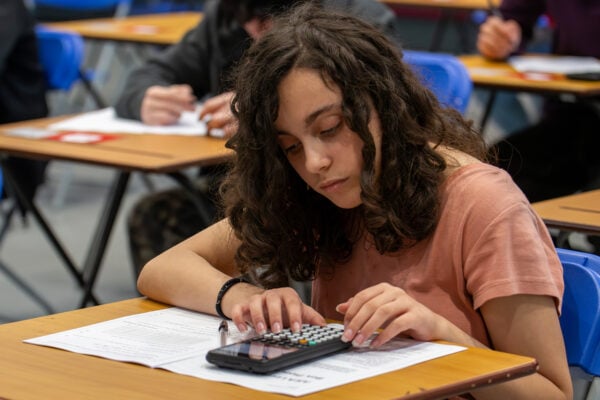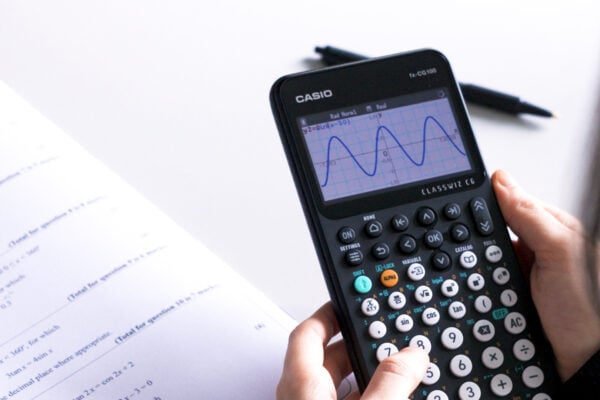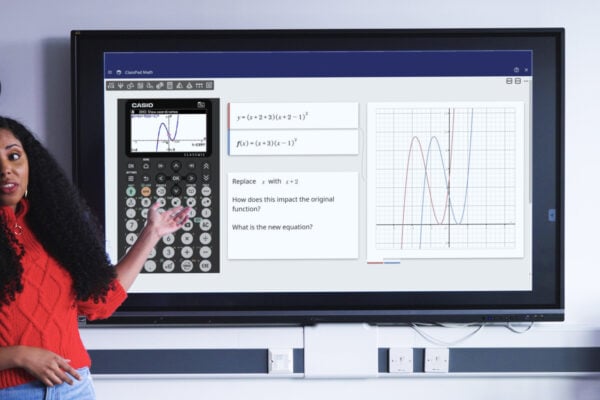How Oxted School is learning the benefits of the fx-CG50 graphic calculator

Oxted School in Surrey has made the switch from scientific calculators to the new Casio fx-CG50 graphic calculator at A-level. They now use them for GCSE too. But why was the school so proactive in making the move? What benefits has it seen? And what has the all-important student feedback been like so far? We visited the school on World Pi Day to find out what the students and staff really think.
Introducing a new way of working
Oxted School began using the fx-CG50 graphic calculators with its Year 12 A-level students. Following the first few months of use, the school began to integrate and promote the new calculators in Years 9, 10 and 11 too, so that students are able to get used to them before they reach A-level. With initial adoption of the calculators reported as being an overall success, we were keen to see it for ourselves. When we visited the school we saw them in an A-level lesson exploring the Large Data Set, and in lessons based around the calculation of Pi using trigonometry.
The formula for better engagement
The students enjoyed being able to draw graphs because they said it helped to develop their knowledge. One of them remarked: “It’s much more engaging and it also helps us understand what different types of graphs look like in general”. Lorraine Bennett, Key Stage 5 Coordinator at Oxted, explained the advantages of the graphic calculator: “The students are very used to using Casio calculators, so they know what a lot of the buttons already do, which makes it much easier for them to learn”. She continued, “our lessons are now much more discussion-based, asking each other questions, let’s learn this together, what happens if we try this – and then they can see straight away.” Daniel Crowhurst added: “We are just in the beginning stages of using the graphic calculators. But our students are already able to explore a lot more than they can with pen and paper. They’re more engaged too, because they have the power to change the variables, change the question, and look at what happens when we alter certain elements – and that leads to a better lesson.”
In the first few weeks of use, students found the calculator intuitive and easy to use. They also liked the fact that it enables them to refer to previous calculations, rather than overwriting them as scientific calculators do.
Pushing the boundaries of possibility
Offering graphs, data analysis and solving many types of equation among numerous different applications, the graphic calculators push the boundaries of what’s possible in the classroom.
He continued: “I think it works well with integration, when you’re trying to find the area between two functions – it’s fantastic for that. It lets them play around with it so much, it allows them to figure out answers that could be beyond their current skill set”.
As with any significant change, the students at Oxted were slightly apprehensive at first – they’d been using the scientific calculators for years. But after quickly getting used to the graphic calculators, they’ve now become used to the benefits: “Finding out what they can do on it just excites them”, said Steven Stodart.
Resounding results
Every student and teacher we spoke to during our day at Oxted enjoyed using the graphic calculators. “It’s really really good – the students benefit from it, which means we benefit from it and that makes our jobs easier knowing that they are progressing” remarked Stodart.
Lorraine Bennett added: “I was a bit sceptical at first as I have been teaching for a really long time. I’m so used to using my scientific calculator, but actually I really enjoy it now and it’s easy to use. I’m looking forward to using it with the large data set.”
One of the students neatly summarised: “It’s easy to use, it’s intuitive and you get used to it quite quickly. The menus are really easy to use as well so it makes learning how to use the calculator much simpler.”



